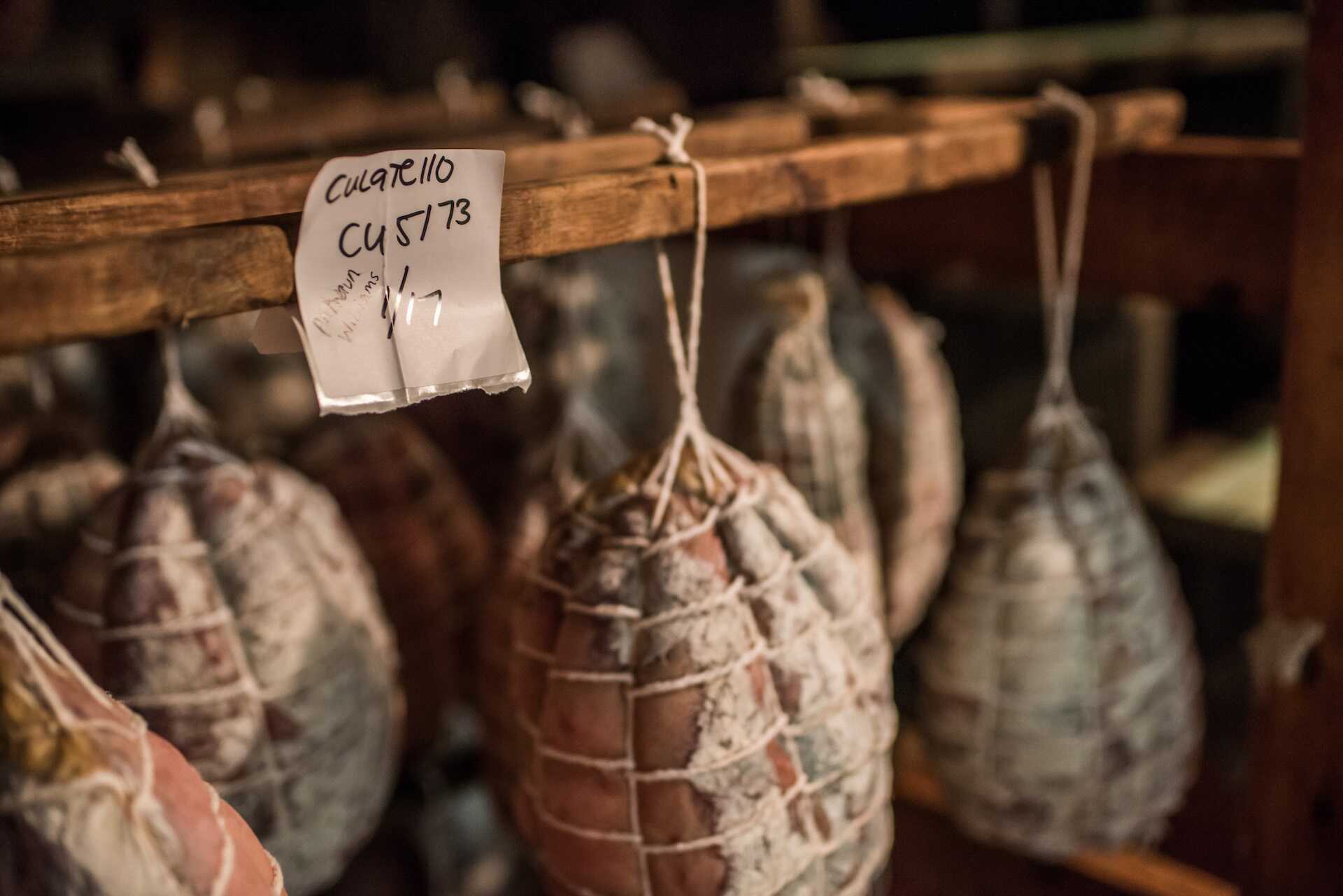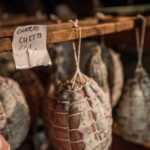
Cura, Maturação e Fermentação são processos fascinantes e riquíssimos para o sabor, textura e conservação dos alimentos. Entender esses processos é um aliado valioso para quem produz alimentos, seja em casa, na indústrias ou em produções artesanais.
Maturação
Maturação da carne é o processo que consiste em manter a carne fresca, logo após o abate e o rigor mortis(rigidez muscular), em temperatura superior ao ponto de congelamento e torna a carne mais macia e aromática. A principal responsável por essas alterações é a atividade enzimática. A manutenção após o abate por 8 a 14 dias sob temperaturas de 0 a 21ºC tem sido praticada por muitos anos e permanece como importante procedimento na produção de carne macia e no desenvolvimento de sabores e aromas característicos do processo de maturação.
Existem diferentes métodos de maturação e os principais são:
- Maturação a seco, onde a carne é mantida em temperaturas entre 1ºC a 3ºC por 6 a 10 semanas em umidade controlada;
- Maturação rápida, onde a carne é mantida em temperaturas mais elevadas, ao redor de 21ºC, durante 2 dias ou menos, com umidade relativa controlada e luz ultravioleta, a fim de reduzir a contaminação microbiana;
- Maturação à vácuo, onde a carne é mantida resfriada em embalagem à vácuo.

Algumas alterações ocorrem durante o processo de maturação da carne, dentre as mais importantes estão o fim do rigor mortis, enfraquecimento do tecido conjuntivo e desenvolvimento do aroma e sabor. O efeito mais desejado na utilização da maturação da carne é o aumento da maciez seguida do sabor e aroma característicos.
A temperatura é o fator de maior importância na maturação e, com o tempo, são as únicas variáveis que afetam a maturação, e que podem ser controladas. Geralmente menores temperaturas de estocagem durante a maturação resultam em carne menos macia, e maiores temperaturas podem acelerar intensamente a ação enzimática natural na carne fresca e a extensão do amaciamento.
Cura
Cura na charcutaria é a redução gradual da quantidade de água presente na carne, também conhecida como atividade de água ou aw. A cura é realizada pela ação do tempo e do uso do sal. O sal em quantidades elevadas retira a água do interior da carne rapidamente mas em alguns processos de cura longos, como na produção de presuntos curados e salames, a ação deve ser lenta e gradual. A ação combinada do sal, tempo e temperatura é o componente chave no sucesso de qualquer produto curado. O sal é essencial pela proteção conferida ao produto durante a cura, ele é a principal barreira de proteção. Uma carne exposta ao tempo por meses e algumas vezes anos, como o presunto de parma, só é possível pela ação protetora do sal e a redução da atividade de água.
Como podem ver no vídeo abaixo o presunto de parma é um exemplo perfeito do processo de cura, pois utiliza apenas o sal como ingrediente. Não há conservante, aditivo ou tempero adicional. É uma obra prima milenar proveniente da necessidade de conservação.
Na charcutaria a cura é frequentemente compreendida, do meu ponto de vista indevidamente, como a ação do sal de cura, que age na proteína conferindo coloração avermelhada, preservação e sabor característico. Mas o sal de cura sozinho(nitrato de sódio/nitrito de sódio) não é suficiente para curar uma carne, pois é utilizado em volume reduzido e sempre combinado com o sal de cozinha, por isso a cura em sí é resultado da ação do sal(cloreto de sódio) e não do sal de cura. Desta forma o sal de cura é um coadjuvante opcional e não obrigatório. Para entender mais sobre o sal de cura, leia o post Sal de cura o que é e quanto usar.
Fermentação
A fermentação é a ação microbiológica de ocorrência natural ou proposital nos componentes presentes nos alimentos e em algumas bebidas, como a cerveja. As melhores cervejas do mundo ainda são produzidas com uma inicial exposição ao ambiente para que haja proliferação natural de organismos benéficos. A fermentação pode produzir ácido lático, dióxido de carbono e álcool. Na panificação o principal benefício provém da liberação do dióxido de carbono, que faz a massa crescer, já na produção de bebidas é almejado o álcool. Na charcutaria a fermentação é utilizada como barreira de proteção e enriquecimento de sabor. O mecanismo essencial na charcutaria é a conversão dos amidos em ácido lático, reduzindo o pH e evitando que outros micro-organismos maléficos proliferem no produto. Essa ação, essencialmente bacteriana, promove o aprimoramento da textura, sabor e aroma dos produtos. O uso da fermentação é muito utilizado em combinação com a cura. Atualmente existem diversas culturas isoladas que podem ser adquiridas e inoculadas durante a produção de alimentos cárneos. Com o tempo o amido e a água disponíveis vão acabando e a ação bacteriana é reduzida drasticamente, deixando o produto protegido por períodos extremamente longos.

A fermentação tem uso vasto na culinária. É utilizada para produzir chucrute, iogurte, pão, queijo, vinho, molho de soja entre muitos outros. Além dos benefícios práticos a fermentação também ganhou força pela alegação de benefício ao sistema digestivo pela ação probiótica conferida aos produtos fermentados.
Referências:
https://pt.wikipedia.org/wiki/Fermentação_lactica
https://opentextbc.ca/meatcutting/chapter/aging-of-meat-carcasses/
http://www.fao.org/docrep/010/ai407e/AI407E14.htm




Olá obrigado por sempre trazer conhecimento já fiz alguma receita sua, me surgiu uma dúvida, posso maturar uma linguiça de churrasco fresca essas a vaco ou congelada compradas em mercado ?
Sim, o que pode fazer é pendurar e deixar secando para ter uma linguiça curada, seca.
Olá, estou estudando pra fazer alguns produtos e minha dúvida no caso do salame é se dá pra ensacar sem aqueles canhões, podem me ajudar?
Eu não tenho tbm e faço a embutidura com o próprio moedor que tenho sem a cruzeta e com disco rim.
amigo qual o numero de contato já tentei pelo que anuncia e não tive retorno grato
No texto “Curado Fermentado ou Maturado?”, onde aborda a fermentação, contempla-se o trecho “(…)conversão dos amidos em ácido lático, aumentando o pH(…)”. Trata-se de uma afirmação equivocada, pois na verdade a produção do ácido lático diminui o pH (aumenta a acidez).
No mais, parabéns pelo conteúdo! Sou entusiasta iniciante da charcutaria e gostei muito do material de vocês.
Oi Rafael, é isso mesmo, foi corrigido no texto, obrigado!
Boa noite e muito importante essa matéria sobre embutidos eu sou um iniciante no campo da charcutaria essa matéria e muito importante para o meu melhoramento nesta área.
Belo trabalho !